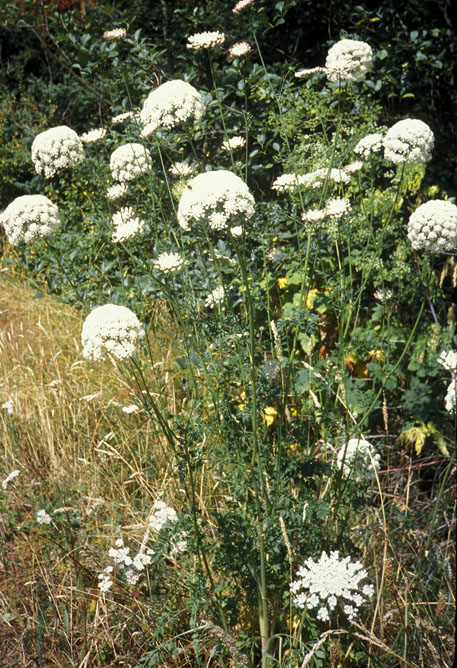
|
| Queen Anne's Lace; Daucus Carota L. |
Carrot Family; UMBELLIFERÆ (APIACEÆ)
|
| Queen Anne's Lace or Wild Carrot differs from regular garden carrot versions by being hairier, white-rooted, with spiny seeds,
and in general being tougher literally. Orange-root garden versions are no pushovers, true, but they cannot compete with their ancestral
race for spartan hardiness. Queen Anne's Lace is a serious weed, best controlled by uprooting just when it is flowering. It is fascinating
how this terrible weed, sometimes called Devil's Plague, was selectively bred over the centuries so that gradually our tame garden carrots
came into being. |
| The species evolved on the plains and meadows of Eurasia, in arid summer regions. Several features helped it thrive successfully.
It produces seeds with abandon, which sprout in autumn
or spring, then grow for varying periods as low clumpy plants, before storing
up enough energy to send up their flowering stems. Their deep, thick taproots, and hairy, strong-flavored foliage, keep the young plants
from being dried out by drought or eaten by grazing animals. |
| The flowerstems ascend in late spring and can grow as tall as 7 feet, their branches bearing many
flat or gently curved clusters of tiny white or pink-tinged flowers, the largest clusters 7 inches wide. In bloom the plants really delight the landscape, and even a
hasty examination shows how rightly they earn the name Laceflowers. Most of the circular clusters are conspicuous with a purplish
center. Flowers around the outermost ring of the cluster are largest. They begin opening as early as mid-June, but the main display is from
late July through August, with a few lingering into mid-September. The flowers attract a wide variety of insects. Even without
pollination, however, the weed can set viable seed; it is self-fertile. The flat flower-clusters turn from their white fragrance, humming with insects,
to green, heavy, dense heads, then contorted brown "bird-nests" of tangled, knotty appearance. Hundreds of seeds can be in each cluster.
The dry clusters respond to rain by loosening, and wind flings the spiny seeds about; they stick to animal fur and to clothes. |
| Some other meadow and roadside weeds also thriving in full sun and blooming in the height of summer include: St. John's-wort,
tansy, goldenrod, wild lettuce and chicory. None are related to Queen Anne's Lace. Close cousins of the weed are: fennel, parsnip, celery,
poison hemlock, caraway and parsley. All these are
umbelliferæ plants, which is easily remembered because their flowers are in
umbrella-like clusters. |
| Wild carrot foliage is deep bluish-green, with a grayish sheen from the numerous hairs. These bristly hairs help it conserve
moisture and make it less palatable to animals. Squish and smell the greens-you will recognize the carrot odor. The leaves are finely dissected
and ferny, similar in shape to those of tame orange carrots, but harder in texture. The root is as much as 2 feet deep, and whitish. The ones
I dug for harvest, in December, ranged from 3 to 8 inches long and from a half to over an inch thick. They're hopelessly tough raw, and
need to be washed, chopped and boiled, then seasoned. Even so, do not expect a fine dining experience. Still, there is something to be said for wild-harvesting: it puts a glow on the cheek and spark in the eye far faster than does a trip to the supermarket. Carrot-based diets,
moreover, are not all mere quackery. Although the nutritional value of wild foods is poorly recorded, it is doubtless significant. The medicinal
value of freshly ingested wild plants is simply amazing, and the carrot has been used to thwart various illnesses. All in all, Queen Anne's
Lace is a weed/wildflower to know. |
| Some people are rightly concerned about confusing it with the deadly poison hemlock
(Conium maculatum). In a very general way the two are similar, both being lacy, white-flowered weeds of rank, upright habit. Close-up, and side by side, their differences are
plainly seen. In brief: the hemlock is stinking, hairless and larger yet more delicate. Hemlock also prefers moister, rich, less arid sites. Queen
Anne's Lace is what we might call indefatigable: resisting boldly the dryness that kills many other plants and surviving severe winter cold
with nary a notice. |
A great population of the weeds is at the University of Washington's Union Bay wildlife sanctuary. This, a former dump, is now
several acres of grassy meadow between Husky Stadium and the Laurelhurst neighborhood. It is easily approached by way of the Center for
Urban Horticulture, or the U.W. E-5 parking lot.
|
Originally published as the Seattle Tilth newsletter Weed of the Month in September 1990, along with an illustration drawn by Annie Figliola.
Back |
|
|

